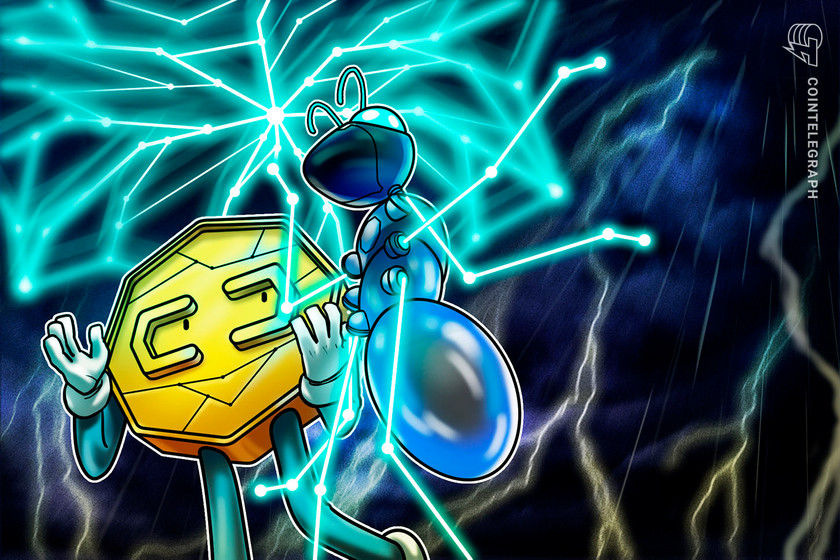 David Marcus, former cryptocurrency head at Meta, is launching Lightspark, another payments company that will use crypto as its central payment tool. The startup, which will have Marcus at the helm as CEO, also features some of Meta’s former employees and will explore the possibilities of using the layer 2 Lightning Network (LN) as a […]
David Marcus, former cryptocurrency head at Meta, is launching Lightspark, another payments company that will use crypto as its central payment tool. The startup, which will have Marcus at the helm as CEO, also features some of Meta’s former employees and will explore the possibilities of using the layer 2 Lightning Network (LN) as a […]
BTC’s latest network difficulty all-time high makes it nearly impossible for bad actors to represent over 50% of the hash rate.
Further distancing itself from any concerns of planned attacks on the blockchain, the Bitcoin (BTC) network established a new mining difficulty all-time high of 31.251 trillion — exceeding the 30-trillion mark for the first time in history.
The creator of Bitcoin, Satoshi Nakamoto, warranted the security of the BTC network through a decentralized network of BTC miners who are tasked with confirming the legitimacy of transactions and minting new blocks.
Given the extensive community support — from developers to hodlers to traders to miners — that spans over 13 years, the BTC network was witness to a historic 10-month-long rally as it achieved mining difficulty of 31.251 trillion.

Mining difficulty safeguards the BTC ecosystem against network attacks such as double-spending, wherein bad actors try to reverse confirmed transactions over the BTC blockchain. Greater mining difficulty demands higher computational power from miners to confirm transactions over the BTC network.
As a result, BTC’s latest network difficulty ATH makes it nearly impossible for bad actors to represent over 50% of the hash rate. According to blockchain.com, the BTC network demands 220.436 million terahashes/second (TH/s) at the time of writing.

Despite the crypto community’s concerns related to the ongoing targeted attacks and an active bear market, BTC continues to position itself as the most resilient blockchain network.
Related: 42.5K BTC reportedly moved from Luna Foundation Guard wallet as UST peg crumbles
Roughly $1.4 billion worth of BTC was reportedly moved from a wallet tied to Luna Foundation Guard (LFG) as the community announced their intent to “proactively defend the stability of the UST peg [and] broader Terra economy.”
Terra’s ecosystem of tokens took a nosedive as the stablecoin UST depegged from its initial $1 value to nearly $0 in a matter of days, sparking commotion among the LUNA and UST investors.
While Terra co-founder Do Kwon attributed the market collapse to coordinated attack against the protocol, current plans for reviving the UST and LUNA ecosystems involve purchasing and redistributing BTC based on requirement.

A class of 2021 Bitcoiner in Mozambique is using the Lightning Network to transact while using Bitcoin to protect his savings.
Bitcoin (BTC) is for all. For you, for Michael Saylor in Miami, and for 38-year-old Jorge, a Mozambican family man who's using the largest cryptocurrency to make ends meet.
Jorge, who goes by his first name for anonymity, lives in the tiny village of Bomba, Mozambique, on its southeast coast. Since the Covid-19 pandemic stripped away tourism from the sleepy surf town, one of Jorge’s primary wage earners–tourism–disappeared.
Luckily, Bitcoin adoption is slowly swelling in Africa–from the Central African Republic across to Senegal and further north. Mozambique is also showing signs it's warming to the world's most popular crypto.

Mozambique is a vast, southern African country that struggles with poverty and corruption. At a GDP per capita of $448, it’s among the world’s poorest countries. According to the World Bank, the pandemic pushed GDP per capita under the $500 mark in 2020.
Fortunately for Jorge, one of the surf camp owners Jorge used to work alongside is a passionate Bitcoiner who took him under his wing in 2021.
Herman Vivier, the founder of the South African Bitcoin-beach-inspired project Bitcoin Ekasi and crypto-friendly surf touring company Unravel Surf Travel, has been helping Jorge protect his savings and diversify his income using BTC.

Jorge wears many hats to earn a living, from surf assistant to arts and crafts seller to SIM card salesman. He told Cointelegraph that he now “accepts Bitcoin” for the services he provides.
Plus, he uses the Lightning Network to instantly swap between South African and Mozambican currencies via the Bitrefill Bitcoin application.
Jorge explains that while “very few people understand Bitcoin here,” he buys and sells phone credit on Bitefill (an app that sells gift cards payable with Bitcoin on-chain or Lightning), easily swapping between ZAR (South African Rand) and MZN (Mozambiquan Metical) currencies.
“It’s the easiest way of exchanging between ZAR and MZN. It’s instant and I’ve actually managed to gain more clients this way.”
While an impoverished nation, Statista reports that almost half the population in Mozambique has a phone subscription. Furthermore, internet penetration in Mozambique is fast growing. More than 1.4 million people (+25%) came online between 2020 and 2021, as the internet now reaches over one-fifth of the population.
To bank with Bitcoin, all you only need is a phone and an internet connection. Given exceedingly high levels of corruption and currency weakness, Mozambique is an unlikely potential hotbed for BTC adoption.
Nonetheless, education remains the biggest obstacle. Jorge concedes that “In the beginning, learning about Bitcoin was pretty difficult!” Vivier helped him to install the necessary applications on his phone and to set him up with a Lightning Network (LN) enabled wallet; they chose MuunWallet, and he took the time to explain Satoshi Nakamoto’s innovation.
Here is Hermann's tweet thread, explaining how Jorge swaps currencies with the LN:
Africa is ripe for #Bitcoin adoption.
— vryfokkenou (@vryfokkenou) May 8, 2022
This is my friend (and former colleague) Jorge using @bitrefill and @MuunWallet in Mozambique, where only about 30% of the population have formal bank accounts, but 70% have mobile internet access. pic.twitter.com/egU5V0xR8k
Thanks to Bitcoin, Jorge now avoids high remittance fees for border payments; he’s able to instantly flick between currencies thanks to the Lightning Network and he has effectively opened up his customer base to the entire world.
Related: Quelle surprise: Central African banks scold the CAR for Bitcoin adoption
Jorge wanted to express his gratitude to Vivier for the assistance, praising the response he’s received from the Bitcoin community so far.
“I’m learning a lot and Bitcoin is making my life easier: it helps to support my family and four children.”
Naturally, living nearby the world-renowned surf point break Tofinho, Jorge’s kids are surfers, and the eldest is a surf teacher.
He concluded that overall thanks to Bitcoin “as coisas são bonitas,” which means thanks to Bitcoin, “Things are pretty.”

Samson Mow, former chief strategy officer at Blockstream, is convinced that DeFi protocols can’t compete with Bitcoin as monetary networks due to their lack of decentralization.
Samson Mow, former chief strategy officer at Blokstream and founder of JAN3, is convinced that most decentralized finance protocols can’t compete with Bitcoin when it comes to providing an effective monetary network because of their lack of decentralization.
As Mow pointed out, DeFi projects are governed by entities that can modify the protocol at will.
“At the fundamental level, money should be immutable,” explained Mow. “If you can change it at will, then you’re no better than a fiat currency governed by the Fed.”
Bitcoin’s decentralization makes it very difficult to modify its protocol, which is why Mow considers it a unique candidate for becoming a truly global monetary system.
Mow pointed out that despite the immutability of Bitcoin’s base layer, developers can still build applications on the Bitcoin blockchain by working with its layer-2 scalability solutions.
In particular, Mow is a strong proponent of the Lightning Network, which allows instantaneous, cheap Bitcoin transactions. By promoting Lightning technologies, Mow is trying to accelerate the path toward hyperbitcoinization — a situation where people will be exchanging Bitcoin without the need to convert it into fiat currency.
“Lightning will displace Visa, Mastercard and everything else,” he stated. “And it reduces costs for merchants, which means better experience and savings for consumers.”
Check out the full interview on our YouTube channel, and don’t forget to subscribe!

The Lightning Network implementation may be against business plans of some crypto exchanges, or simply not a priority for others, several community members suggested.
The Bitcoin Lightning Network integration started to take off among the cryptocurrency exchanges worldwide. However, some of the world’s largest crypto trading platforms seemingly are not in the hurry to integrate the protocol.
Last week, Robinhood crypto trading app became the latest major industry player to announce the Lightning integration, following in the footsteps of BitPay and the Kraken crypto exchange.
As the main goal of the Lightning integration is to reduce the cost of Bitcoin (BTC) transactions and accelerate the network transfers, one may wonder what cryptocurrency exchanges have still not added the Lightning support.
Not everyone is happy with the pace of Bitcoin LN adoption. David Coen, a software quality assurance tester and crypto enthusiast, is disappointed at the lack of progress for the Lightning Network integration among major crypto exchanges. He compiled data from official sources, social media presences and Lightning explorers like 1ML and Amboss, only to find out that Binance, Coinbase and the major South Korean crypto exchange Bithumb are not in the list of “Lightning exchanges.”
Despite providing comprehensive information about the Lightning Network on their websites, both Coinbase and Binance declined to comment on their potential Lightning Network integration plans to Cointelegraph.
FTX — which is not mentioned in Coen’s list — has refused to comment as well. In January last year, FTX said that it “probably pays more in transaction fees than any other single entity in the world” on its official Twitter account.
There are apparently a wide number of possible reasons why some of the world’s largest crypto exchanges have not added the Lightning support so far.
One Redditor suggested that the Lightning Network availability would be essentially associated with fewer incentives to keep Bitcoin on exchanges like Binance due to expensive withdrawals. “It may not be to Binance advantage to implement it though. I personally want to use the Lightning Network to transfer all my BTC trading to cold storage,” he said.
According to Coen, the Lightning implementation could be simply not a priority for some major crypto exchanges, or even against their business plans for others.
“I believe Binance has no interest in integrating Lightning Network deposit or withdrawal because it could be against their business plans,” Coen said. He suggested that Binance may be more interested in promoting usage of its proprietary blockchain networks, including the Binance Beacon Chain and the Binance Smart Chain, particularly for withdrawals.
Coen emphasized that Lightning not only allows to move Bitcoin at a lower cost but also enables users to hold actual BTC, stating:
“With Lightning Network, users are able to move funds even for free, if they have a direct channel to the exchange and most importantly, they have real bitcoin instead of a Bitcoin token on an Ethereum Virtual Machine network.”
The Lightning enthusiast also doesn’t expect other exchanges like Coinbase to integrate Lightning support in the near future “since the priority seems to be to integrate as many altcoins as possible and follow the trends of the market,” he said. Coen added that nonfungible token (NFT) support appears to be more a priority for Coinbase over Lightning, citing the company’s NFT initiative released officially last year. The expert’s remarks echoed some similar comments in the community.
According to some community members, Lightning is still a cutting-edge development today, which makes large crypto exchanges take significant time and effort to make such improvements.
However, with exchanges like Bitfinex, OKX (formerly OKEx) and Kraken adding Lightning, “it’s becoming less cutting edge and more of a necessity to be competitive,” a spokesperson for the Amboss explorer told Cointelegraph.
“The user experience with Lightning is superior and exchange users will be looking for the easiest way to make deposits and withdrawals from their exchange of choice. [...] Lightning support is a necessity for users who need to execute fast trades,” the representative stated.
Related: Lightning to strike Shopify merchants with addition of BTC payments
Launched in March 2018, the Lightning Network is a Bitcoin layer-two protocol designed to enable faster and cheaper BTC transactions. Bitfinex is believed to be the first crypto exchange in the world to add Bitcoin Lightning support for payments by integrating the protocol in December 2019.
 Four years ago, a mobile game application called “Bitcoin Miner” came out that simulates bitcoin mining but at the time, the game’s development team Fumb Games could not integrate bitcoin rewards. On Thursday, Fumb Games revealed it has partnered with the fintech firm Zebedee and the Bitcoin Miner game now allows players to earn real […]
Four years ago, a mobile game application called “Bitcoin Miner” came out that simulates bitcoin mining but at the time, the game’s development team Fumb Games could not integrate bitcoin rewards. On Thursday, Fumb Games revealed it has partnered with the fintech firm Zebedee and the Bitcoin Miner game now allows players to earn real […]
Bitcoin’s layer 2 scaling solution, the Lightning Network, has seen payment volume increase by over 400% as real adoption grows.
A new report highlights how the Lightning Network has grown in popularity as a way of transferring digital assets quickly and efficiently around the globe.
CNBC today told the story of Alena Vorobiova, a Ukrainian refugee currently seeking sanctuary in Poland. Vorobiova used Lightning to transfer $100 worth of Bitcoin from Miami, where it was then withdrawn from an ATM in the equivalent Polish currency — all within the space of three minutes.
That’s the sort of low cost, high speed transaction that has seen the Layer 2 scaling solution for Bitcoin grow 410% in payment volume over the past year.
According to the report published by Arcane Research, the number of payments that occurred on the Lightning Network in the past year doubled while the total value of those payments quadrupled.
The report warned that the widely-cited public metrics used to measure Lightning Network adoption — most commonly total value locked (TVL) — underestimate the size of the network as they fail to count private channels and invisible nodes. Additionally, the metrics don’t reflect real world Lightning Network usage, whereas looking explicitly at payment volume paints a clearer picture of real Lightning adoption.
A partial explanation for the surge in payment is owed to the enormous increase in the number of users who have recently gained access to the Lightning Network. This is through apps like El Salvador’s Chivo Wallet and US-based payment application, CashApp.

Arcane estimated that in Aug. 2021, roughly 100,000 users had access to Lightning payments. By March of this year, over 80 million people had the ability to access payments on the Lightning Network , which shows that there is a large potential user base.
The report found that roughly 50% of the value of all payments came from direct transactions between individuals — Peer-to-Peer (P2P) transactions. Almost one third of the payment value came from exchange withdrawals and deposits, with the remaining 20% coming from purchases made through some form of vendor.
Related: Lightning to strike Shopify merchants with addition of BTC payments
Despite Bitcoin being originally designed as an electronic cash system — the sluggishness of the Bitcoin networks in resolving transactions gave rise to layer-2 solutions. The Lightning Network was launched in March 2018 to provide faster and cheaper BTC transactions.

Mobile payments titan Cash App is launching a new feature that will allow users to get paid in the leading crypto asset Bitcoin (BTC). Speaking at the Bitcoin 2022 conference in Miami, Cash App’s crypto product lead Miles Suter says that the payments app has rolled out its ‘Paid in Bitcoin’ feature, allowing customers to […]
The post Payments Giant Cash App Unveils New Feature That Allows Users To Get Paid in Bitcoin (BTC) appeared first on The Daily Hodl.

The CEO of Lightning Network wallet Strike says the payments platform is teaming up with point of sale giants Shopify, NCR and Blackhawk Network to revolutionize the payments industry. In a speech at the Bitcoin 2022 Conference in Miami, Jack Mallers announced that any Shopify-supporting website can now process Bitcoin (BTC) payments on the Lightning Network. “This […]
The post Jack Mallers Announces Strike Partnering With POS Giants To Allow Bitcoin (BTC) Payments at Major Retailers appeared first on The Daily Hodl.